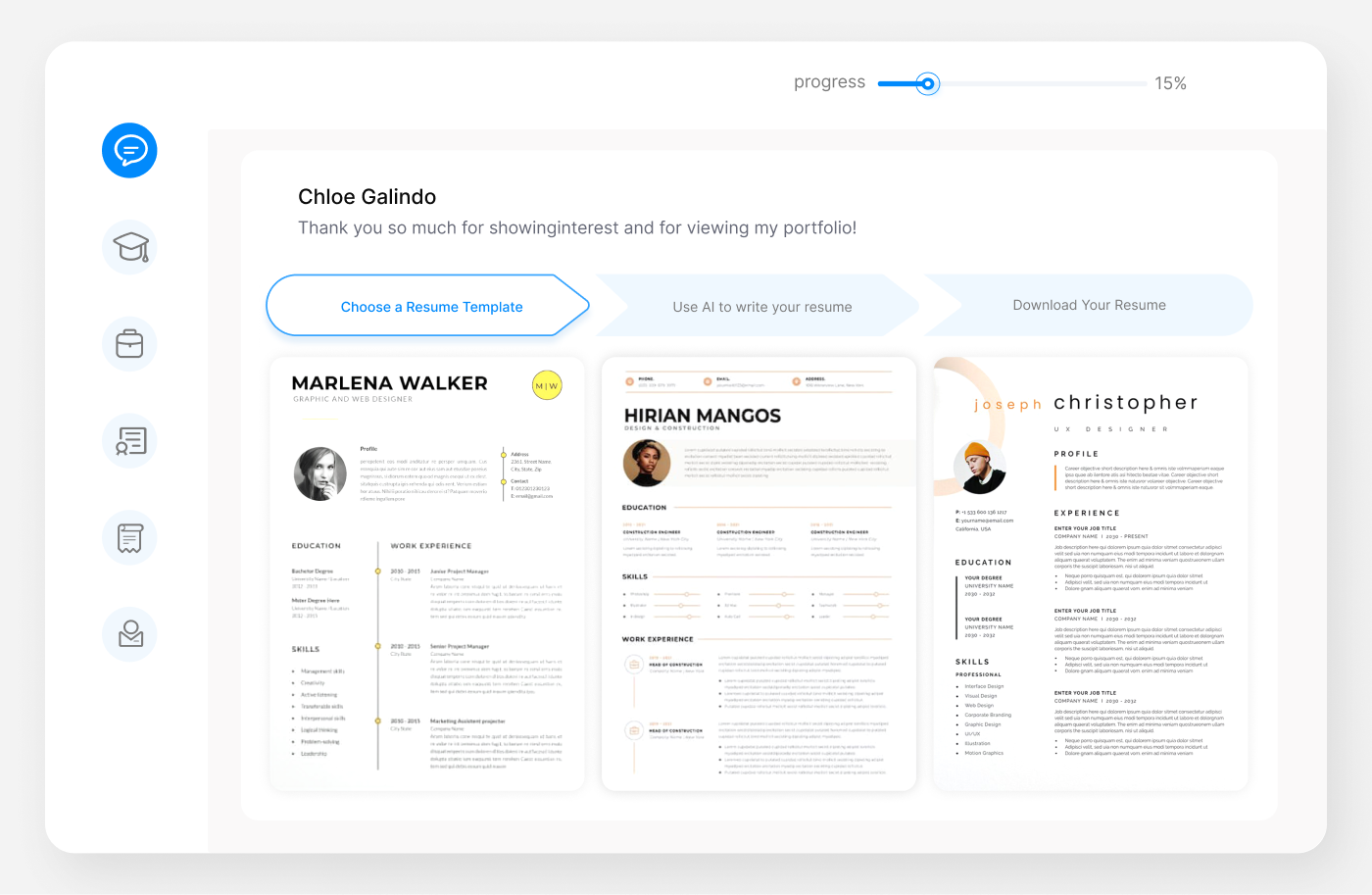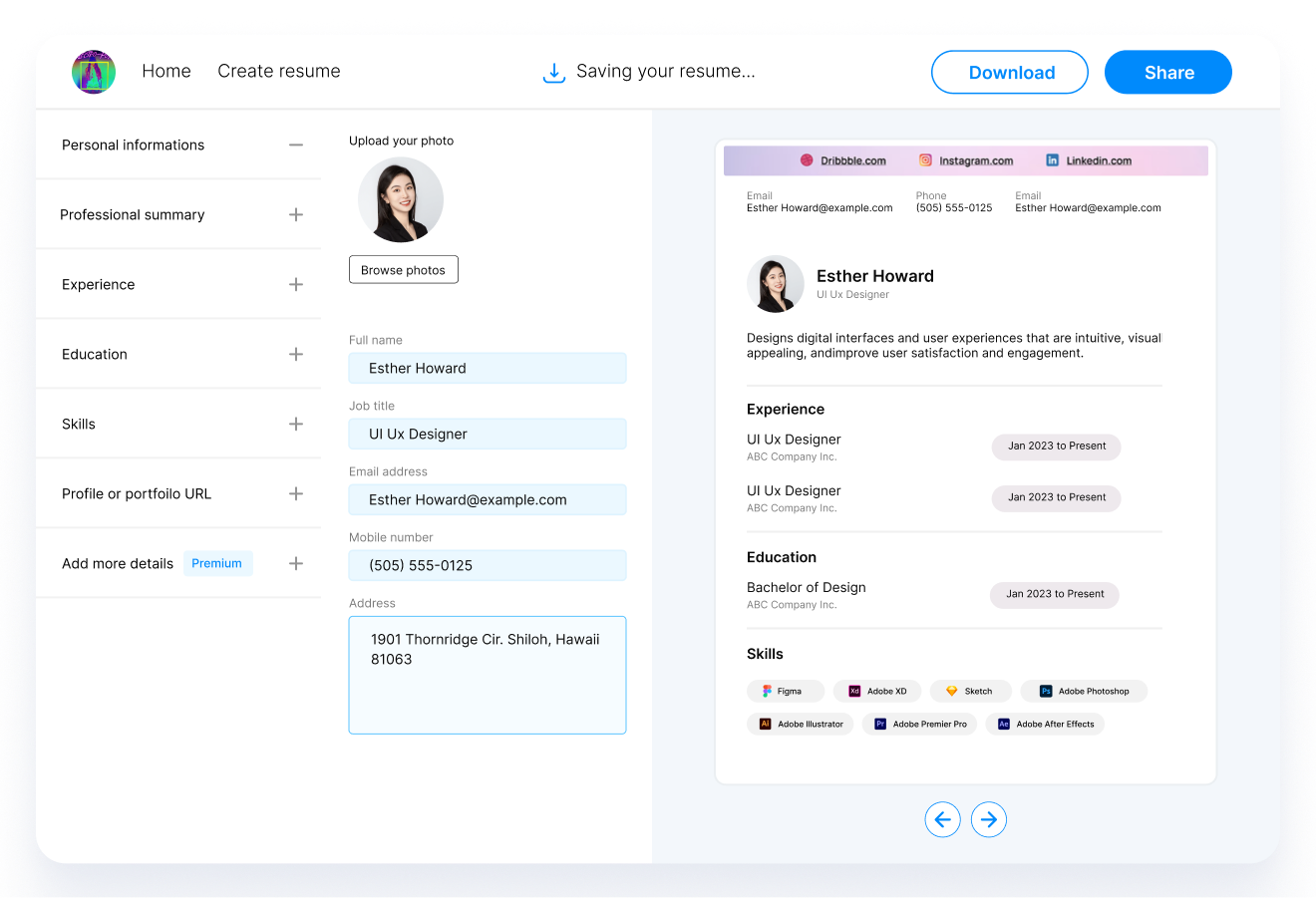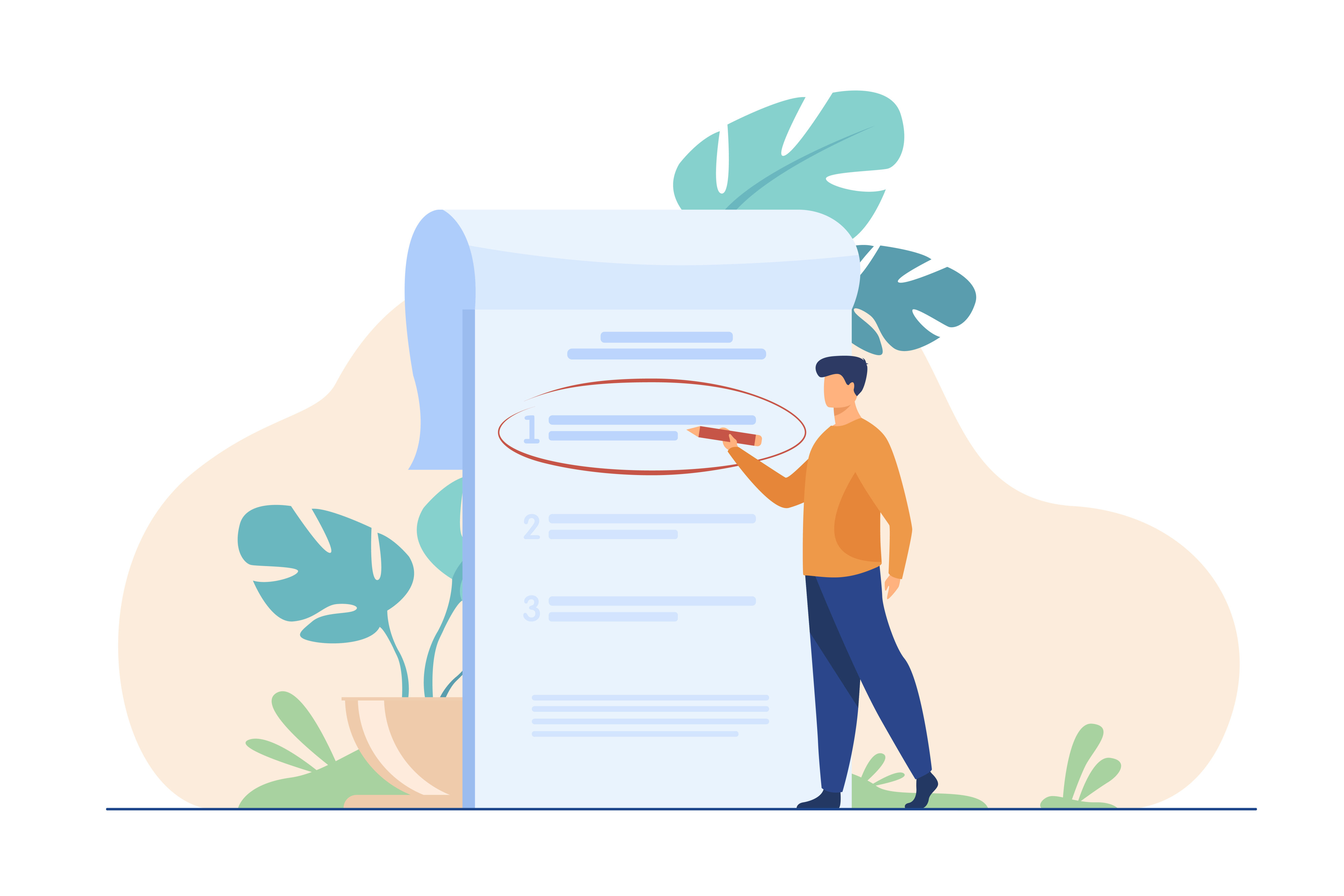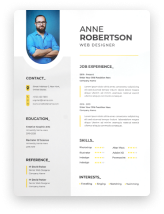In the ever-evolving world of technology, standing out as a Full Stack Developer requires more than just technical prowess. Your resume is your gateway to exciting career opportunities, and this guide is your compass. We delve into the intricacies of crafting a resume that not only highlights your skills but also speaks the language of recruiters and hiring managers in the IT sector. Whether you are a seasoned developer or stepping into this dynamic field, our tips, examples, and industry insights will equip you with the tools to create a resume that resonates with excellence and professionalism.

Full Stack Developer Resume Example
Creating a Standout Resume for Full Stack Developers
Jordan Lee Full Stack Developer
Phone: (555) 123-4567
Email: jordan.lee@example.com
LinkedIn: linkedin.com/in/jordanlee
Professional Summary
Innovative and solution-focused Full Stack Developer with over 5 years of experience in designing, developing, and implementing interactive and scalable web applications. Proficient in a broad range of programming languages and frameworks, with a passion for leveraging emerging technologies to solve complex business challenges. Demonstrated ability to lead projects and collaborate effectively with diverse teams.
Professional Experience
Senior Full Stack Developer
Digital Innovations Inc.
New York, NY | June 2018 -- Present
-
Lead a team of 5 developers in creating responsive and user-friendly web applications for e-commerce clients.
-
Spearheaded the transition to a microservices architecture, improving application scalability and performance.
-
Implemented continuous integration/continuous deployment (CI/CD) pipelines, reducing deployment times by 50%.
Full Stack Developer
Tech Solutions LLC, San Francisco, CA
July 2015 -- May 2018
-
Developed full-stack web applications using JavaScript, React, Node.js, and MongoDB.
-
Collaborated closely with UI/UX designers to create intuitive user interfaces.
-
Enhanced application security by integrating advanced authentication and authorization mechanisms.
Education
Bachelor of Science in Computer Science
University of Washington| May 2015
Technical Skills
-
Languages: JavaScript, Python, Java, C#
-
Frameworks: React, Node.js, Angular, .NET
-
Databases: MongoDB, MySQL, PostgreSQL
-
Tools: Docker, Jenkins, AWS, Git
Certifications
-
Certified AWS Solutions Architect
-
Full Stack Web Development Certification, Code Academy
Professional Memberships
-
Member, Association for Computing Machinery (ACM)
-
Member, Full Stack Developers Meetup, New York
Volunteer Experience
- Mentor for CodeNewbie, guiding beginners in web development projects.
Structuring Your Full Stack Developer Resume: A Strategic Approach
Crafting a resume as a Full Stack Developer is not just about listing your skills and experiences. It's about presenting them in a way that is both compelling and easy to read. The right structure can be the difference between your resume standing out or being overlooked.
Understanding the Importance of Clarity and Organization
Your resume should be a clear map of your career journey, showcasing your skills and achievements. Begin with your contact information, followed by a strong professional summary that gives a snapshot of your capabilities and experience.
Crafting the Professional Summary
This section is your elevator pitch. It should highlight your years of experience, key skills, and major accomplishments. Keep it concise, impactful, and tailored to the Full Stack Developer role.
Detailing Your Work Experience
List your professional experiences in reverse chronological order. Each entry should include your job title, the company's name, location, and the dates of your employment. Under each role, use bullet points to detail your responsibilities and achievements. Quantify your achievements where possible, such as "Reduced server response time by 30% through optimized code."
The Education Section
Include your highest level of education, the name of the institution, and graduation date. If you're a recent graduate, you can include relevant coursework or projects.
Highlighting Technical and Soft Skills
Separate your skills into technical and soft skills. For technical skills, list the languages, frameworks, and tools you're proficient in. Soft skills might include problem-solving, teamwork, or communication.
Certifications and Additional Training
In a field that's constantly evolving, certifications can give you an edge. Include any relevant certifications or ongoing training, especially those that are highly regarded in the tech community.
Tailoring Your Resume
The Final Polish
Proofread your resume meticulously. Formatting should be consistent, and there should be no typos or grammatical errors. Consider getting feedback from mentors or colleagues in the field.
In conclusion, a well-structured resume is crucial for a Full Stack Developer. It should effectively communicate your skills, experiences, and achievements in a format that is easy for potential employers to navigate.
Crafting a Compelling Resume Summary or Objective for Full Stack Developers
The Art of the Perfect Summary
A resume summary or objective is more than just an opening statement; it's your first impression. For a Full Stack Developer, this section should be a concise, impactful snapshot of your skills, experience, and what you bring to the table. Here's how to make it count:
Why a Great Summary Matters
-
Captures Attention: In a competitive field like Full Stack Development, grabbing the recruiter's attention quickly is crucial.
-
Highlights Strengths: It's your chance to showcase your strongest tech skills and professional achievements.
-
Sets the Tone: A well-crafted summary establishes your professional identity and what you're looking for in your next role.
Crafting Your Summary
-
Focus on Relevance: Tailor your summary to align with the job description, highlighting the skills and experiences that are most relevant.
-
Showcase Achievements: Mention significant accomplishments, like leading a successful project or implementing a solution that improved efficiency.
-
Use Specifics: Include years of experience, key skills, and any specializations. For instance, "Expert in JavaScript and React with 5 years of experience in agile environments."
The Difference Between a Summary and an Objective
-
Summary: Ideal for experienced professionals. Focuses on your career highlights and skills.
-
Objective: More suited for new graduates or those changing careers. Focuses on your career goals and how they align with the company.
Examples
Resume Summary for an Experienced Developer:
"Seasoned Full Stack Developer with 7+ years of experience in developing scalable web applications using JavaScript, React, and Node.js. Proven track record in leading development teams, optimizing code efficiency, and implementing innovative solutions in tech startups."
Resume Objective for a New Graduate:
"Recent Computer Science graduate with a passion for developing user-centric web applications. Seeking a challenging Full Stack Developer role to utilize my skills in JavaScript and React, and to contribute to innovative projects in a dynamic team environment."
Showcasing Work Experience on a Full Stack Developer's Resume
Crafting the Work Experience Section with Impact
For Full Stack Developers, the work experience section is crucial. It's where you demonstrate your technical skills, problem-solving abilities, and contributions to previous employers. Here's how to make this section shine:
Structure of the Work Experience Section
-
Chronological Order: List your jobs in reverse chronological order, starting with the most recent.
-
Clear Formatting: For each position, include your job title, the company's name, location, and dates of employment.
-
Bullet Points for Key Responsibilities and Achievements: Use bullet points to describe what you did in each role. Focus on achievements rather than just duties.
Emphasizing Achievements and Impact
-
Quantify Your Impact: Use numbers to highlight your accomplishments, such as "Developed an application used by 10,000+ users" or "Improved system performance by 25%."
-
Project-Based Approach: Highlight specific projects you've worked on and your contributions. This approach showcases your hands-on experience and the value you brought to the team.
Tailoring Your Experience
-
Match the Job Description: Emphasize aspects of your previous jobs that are most relevant to the position you're applying for.
-
Use Keywords: Incorporate keywords from the job listing to get past applicant tracking systems (ATS).
Common Pitfalls to Avoid
-
Being Too Vague: Avoid generic descriptions. Be specific about your role and contributions.
-
Overloading with Technical Jargon: While technical details are important, ensure they are understandable to non-technical recruiters.
Example of a Well-Crafted Work Experience Section
Senior Full Stack Developer Toogle
San Francisco, CA | January 2018 - Present
- Led a team of 6 in developing a high-traffic e-commerce platform, resulting in a 40% increase in online sales.
- Implemented a new React-based frontend, improving the user experience and increasing customer engagement by 30%.
- Developed RESTful APIs using Node.js, significantly enhancing the application's scalability and performance.
By following these guidelines, your work experience section will not only showcase your technical skills but also demonstrate your ability to deliver results, making your resume stand out to potential employers.
Highlighting Education in a Full Stack Developer Resume
The Role of Education on Your Resume
For a Full Stack Developer, while your technical skills and experience take the front seat, your educational background still plays a vital role. It provides context about your knowledge base and foundation in the field. Here's how to effectively present your education on your resume:
Structuring the Education Section
-
Placement: Place your education section after your experience section, especially if you have a few years of professional experience.
-
Information to Include: For each degree, include the degree type, major, the name of the institution, and graduation year. If you're a recent graduate, you can also include your GPA if it's high.
For Recent Graduates
-
Highlight Relevant Courses or Projects: If you're a new graduate, you can detail relevant courses or projects that demonstrate your skills and knowledge in full-stack development.
-
Include Internships: Internships are valuable experiences. Include any internships that are relevant to full-stack development.
For Experienced Professionals
-
Focus on Advanced Education: If you have pursued any advanced degrees or specialized certifications, make sure to highlight them.
-
Continuing Education: In a field like full-stack development, technologies constantly evolve. Include any ongoing or recent courses that keep your skills up-to-date.
Example of an Education Section
Bachelor of Science in Computer Science
University of Arkansas | May 2015
- Relevant Courses: Web Development, Database Systems, Software Engineering
- Senior Project: Developed a full-stack web application for campus event management using JavaScript, Node.js, and MongoDB.
Additional Tips
-
Certifications: If you have industry certifications (e.g., AWS Certified Developer, Full Stack Web Development from Codecademy), include them in a separate section.
-
Workshops and Seminars: Participation in relevant workshops and seminars can also be included, demonstrating your commitment to learning and staying current in your field.
Your education section should reinforce your resume by highlighting the foundational knowledge and continued learning that supports your full-stack development career.
Enriching Your Full Stack Developer Resume with Key Skills
Crafting the Skills Section: A Strategic Approach
For Full Stack Developers, the skills section is more than a list; it's an opportunity to showcase the technical and soft skills that make you the ideal candidate. Here's how to curate a compelling skills section:
Technical Skills: The Backbone of Your Resume
-
List Relevant Programming Languages: Include languages like JavaScript, Python, Ruby, etc., that are pertinent to full-stack development.
-
Frameworks and Libraries: Mention your proficiency in frameworks like React, Angular, Node.js, and others.
-
Database and Server Knowledge: Showcase your ability to work with databases like MySQL, PostgreSQL, MongoDB, and your experience with server-side management.
-
Version Control and DevOps Tools: Skills in tools like Git, Docker, Jenkins, and AWS are highly valued.
Soft Skills: The Human Element
-
Problem-Solving: Demonstrate your ability to tackle challenging issues and find effective solutions.
-
Teamwork and Collaboration: Highlight your experience working in diverse teams and your ability to collaborate effectively.
-
Communication: Your ability to communicate complex technical concepts clearly is crucial.
-
Adaptability: Show that you can thrive in fast-paced or changing environments.
Balancing Technical and Soft Skills
-
Customize for the Job: Tailor your skills section based on the job description. Focus on the skills that are most relevant to the position.
-
Quantify and Qualify: Whenever possible, back up your skills with specific examples or experiences from your past roles.
Example of a Skills Section
Technical Skills:
- Languages:
- JavaScript (ES6+),
- Python,
- Java,
- C#
- Frameworks:
- React,
- Node.js,
- Angular,
- Vue.js
- Databases:
- MongoDB,
- MySQL,
- PostgreSQL
- Tools:
- Docker,
- Jenkins,
- AWS,
- Git
Soft Skills:
-
Strong analytical and problem-solving skills
-
Effective communication and teamwork abilities
-
Adaptability in fast-paced tech environments
-
Continuous learner with a passion for emerging technologies
Adding Value to Your Full Stack Developer Resume with Additional Sections
The Power of Additional Sections
In a Full Stack Developer's resume, while the core sections are essential, additional sections can provide a more comprehensive view of your capabilities and interests. These sections can showcase your broader skillset, certifications, or activities that demonstrate your passion and commitment to the field.
Suggested Additional Sections
-
Certifications: Include any relevant certifications that enhance your qualifications as a Full Stack Developer. For example, AWS Certified Solutions Architect, Certified Scrum Master, or Full Stack Web Development certifications.
-
Projects: Detailing side projects or contributions to open-source projects can demonstrate practical skills and a proactive approach to problem-solving. Include the project name, a brief description, and the technologies used.
-
Awards and Honors: If you've received any awards or honors that are relevant to technology or leadership, include them to showcase recognition for your efforts and achievements.
-
Volunteer Experience: Participation in tech meetups, hackathons, or volunteer work in tech communities can reflect your enthusiasm and dedication to the field.
-
Professional Memberships: Membership in professional organizations like the Association for Computing Machinery (ACM) or local developer groups can indicate your engagement with the tech community.
Example of an Additional Section
Certifications:
- AWS Certified Solutions Architect -- Associate
- Full Stack Web Development Certification, Codecademy
Side Projects:
- Home Inventory App:
- Developed a React-based web app for home inventory management, using Firebase for real-time database and authentication. The app assists users in tracking household items for insurance purposes.
Professional Memberships:
-
Member, Association for Computing Machinery (ACM)
-
Organizer, Local JavaScript Meetup Group
These additional sections are your opportunity to personalize your resume and give potential employers a glimpse into your broader professional persona. They can set you apart from other candidates by highlighting your unique skills and experiences.
Writing an Effective Cover Letter for Full Stack Developer Applications
The Importance of a Cover Letter
A cover letter is a vital part of your job application as a Full Stack Developer. It complements your resume by allowing you to express your enthusiasm for the role, explain your unique value, and show a bit of your personality. Here's how to craft a cover letter that makes an impact:
Key Elements of a Full Stack Developer Cover Letter
-
Personalization: Address the letter to the hiring manager or recruiter by name, if possible. Avoid generic salutations like "To Whom It May Concern."
-
Introduction: Start with a strong opening that captures the reader's attention. Briefly introduce yourself and express your interest in the position.
-
Body: Highlight your most relevant experiences and skills. Connect your background to the job description and explain how you can contribute to the company's goals.
-
Technical and Soft Skills: Emphasize both your technical expertise and soft skills like problem-solving, communication, and teamwork.
-
Closing: End with a call to action, expressing your eagerness to discuss your qualifications further in an interview.
Tailoring Your Cover Letter
-
Match the Company's Culture: Research the company and align your tone and content with its culture and values.
-
Specific Examples: Provide specific examples of your work and achievements that are relevant to the job requirements.
Avoiding Common Mistakes
-
Length: Keep it concise; one page is ideal.
-
Repetition: Don't repeat your resume. Instead, provide new insights into your experiences and skills.
-
Typos and Errors: Proofread carefully to avoid spelling or grammar mistakes.
Example of a Cover Letter Opening
Dear [Hiring Manager's Name],
I am writing to express my interest in the Full Stack Developer position at [Company Name] as advertised on [Where You Found the Job Posting]. With a strong background in developing scalable web applications and a passion for innovative technology solutions, I am excited about the opportunity to contribute to your team.
In my previous role at [Previous Company], I led a project to...
A well-written cover letter can significantly increase your chances of getting noticed and moving forward in the application process. It's your chance to make a personal connection with the employer and stand out among other candidates.

Final Thoughts and Key Takeaways for Crafting a Full Stack Developer Resume
Summarizing the Essentials
Creating a compelling Full Stack Developer resume is a critical step in your job search journey. It's not just about listing your experiences and skills; it's about telling a story that aligns with the needs and values of your potential employer. Here are the key takeaways to remember:
Recap of Important Points
-
Tailored Content: Customize your resume for each job application. Focus on the skills and experiences that are most relevant to the job description.
-
Clarity and Conciseness: Keep your resume clear, well-organized, and concise. Avoid unnecessary jargon and keep the layout easy to read.
-
Highlight Achievements: Use specific examples to showcase your achievements. Quantify your impact wherever possible.
-
Balance of Skills: Include a mix of technical and soft skills. Show how you can not only perform the job but also contribute to the team and company culture.
-
Additional Sections: Use additional sections like certifications, projects, or volunteer work to provide a fuller picture of your qualifications and interests.
-
Cover Letter: Complement your resume with a cover letter that provides more context about your background and enthusiasm for the role.
Continuous Improvement
-
Feedback: Seek feedback on your resume from mentors or peers in the field.
-
Stay Updated: Keep your resume updated with new skills, experiences, and certifications.
Frequently Asked Questions About Writing a Full Stack Developer Resume
Q: How long should my Full Stack Developer resume be?
A: Aim for one to two pages, depending on your experience level. Be concise but comprehensive.
Q: Should I include personal projects?
A: Yes, especially if they demonstrate relevant skills or achievements.
Q: How often should I update my resume?
A: Regularly update your resume, especially after completing significant projects, learning new skills, or achieving new certifications.
Q: Can I use a template for my resume?
A: Templates can be a good starting point, but customize it to reflect your unique experiences and skills.
Q: Is it necessary to include a cover letter?
A: While not always required, a cover letter can significantly boost your chances, especially if it well articulates your interest and suitability for the role.
By following these guidelines and tips, you'll be well on your way to creating a Full Stack Developer resume that stands out and effectively showcases your skills and experiences.
Recommended Reading









